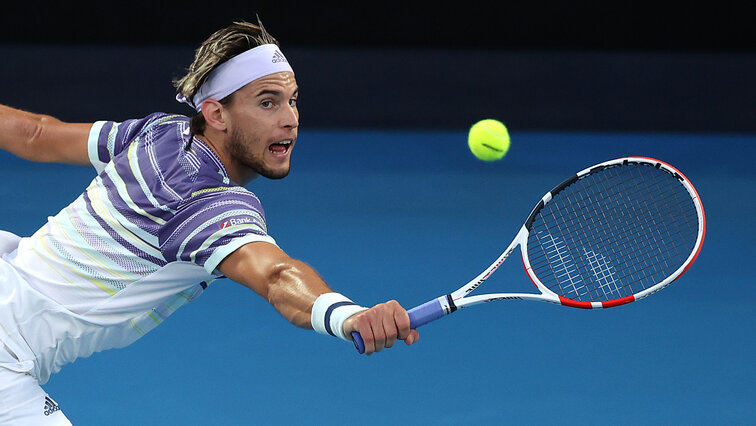Who is more perfect? Thiem, Djokovic, Murray or their rackets?
The daily Kasi provides information. We have known this for a good week in which Christopher Kas entertains us with interesting guests from and around the tennis world on the tenninetnews Instagram page from 6 p.m. In addition to greats like Dominic Thiem , Boris Becker , Nicolas Massu and Dennis Novak , there are also completely different people from the business who provide interesting insights.
by Andrea Schlager
last edit:
Apr 02, 2020, 08:01 am

A guest who has had a look behind the scenes of the tennis machinery several times is Max Wimmer, a member of the Pro Player and Test Management Team at Head.
The question of every tennis fan and hobby player is very clear: what does my ideal racket look like? What do I need to make my hobby game even better, maybe I can become number one in the club or just to have even more fun in my favorite sport? We vary with racket models, longbody or normal, as well as grip strength and the very ambitious even with weight.
This question, of course, is all the more relevant to those whose life is tennis: the tennis stars of our time. With racket size and grip strength it is of course not enough, so we listened very closely to Max Wimmer in Kasi's last insta and also interviewed him in detail to be able to solve one or the other secret.
What is important for the professional
The Austrian company Head with its headquarters in Kennelbach, Vorarlberg has 400 players from the WTA and ATP Tour under contract. Tests are carried out directly in Kennelbach and the respective racket is adapted to stars such as Alexander Zverev , Novak Djokovic or Dennis Novak.
The main criteria are weight, balance and swing weight, in addition there is a handle, covering pattern and occasionally even drilling pattern.
The rackets are basically produced in China and arrive in Vorarlberg with a minimum weight of 270 - 280 grams. The perfect weight to be fine-tuned further. The difference to the hobby player who buys his racket in the shop and wants to tune it himself - these rackets are already installed and have a weight of 305 - 320 grams. So it can be set less fine than the professional, even if the clubs are otherwise identical.
What are the basic tests in the racket industry like?
Testing is ongoing in Kennelbach. Two people are regularly on the court for this, these are the former Austrian tennis professional Johannes Ager and Max Wimmer from Head (currently due to the corona crisis, testing is only done with a ball machine, not with a hitting partner).
The tests should be carried out without prejudice, so for example they get ten black lacquered clubs without knowing the differences, play these clubs through and take their notes. Then it goes to the evaluation and the rackets are adjusted.
All tennis professionals love this radar control
So how does testing and fine tuning work for the professional? Wimmer explains using the example of the acting tennis No. 1 Novak Djokovic. After his elbow surgery in early 2018, he also had to adapt his racket. The Serb tested 30 clubs in just under 3 weeks. During a 2-3 day visit to Kennelbach, the professional will also have access to a radar device specially built for tennis, with which speed and spin are measured. The collection of this data enables the club to be further tuned directly on site.
Immediately afterwards, measurements are taken again. A difference of about 3 km / h is almost a milestone. Nevertheless, speed is not everything, as the controllability must not suffer from more speed.
In the case of Djokovic, above all the weight and balance of the racket changed after his operation. He currently plays a 325 gram stick.
Dominic Thiem and his Babolat Pure Strike - that's what he attaches importance to
Dominic Thiem is playfully a heavyweight in today's tennis world, but racket technology is an absolute lightweight. His Babolat Pure Strike only weighs 317 grams, he has been using this racket with a grip strength of 2.5 for over five years. Dominic does not have any special requests for his racket, so he also plays a normal string pattern of 18/20. Dominic has six rackets in his bag per tournament and consumes between 18 and 24 racquets per year. However, he already puts emphasis on one thing - since the French Open 2019, the design of his frame has been individually red / black. The black side must be on top when playing, otherwise the tournament win will not work, the Lichtenwörther grins in the ServusTV interview in January.
Young players in particular tend to test less, as they often did not have the luxury of fine tuning before and therefore got used to their material very well. Fernando Verdasco, on the other hand, or formerly Tommy Haas, were players who were constantly looking for change and optimization.
Interestingly enough, a player who also belongs to the multi-testers is Andy Murray. But he never changed much. He is also the player, amazed Wimmer in a conversation with Kasi, who can say to the gram exactly what has been changed on the racket. A real sir in all situations.
Why do some players keep testing and others seem to be satisfied faster?
